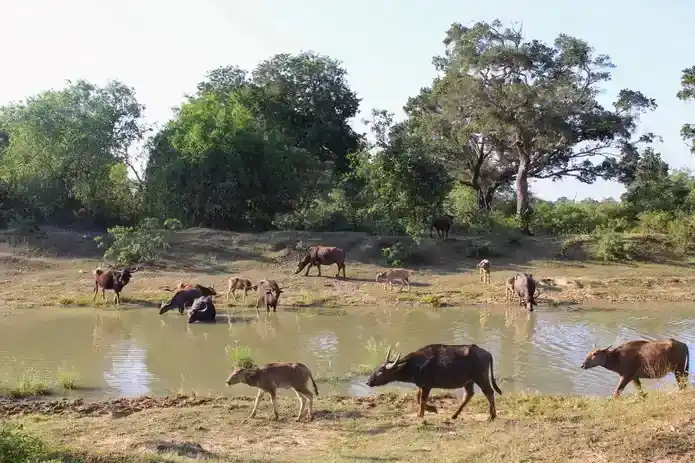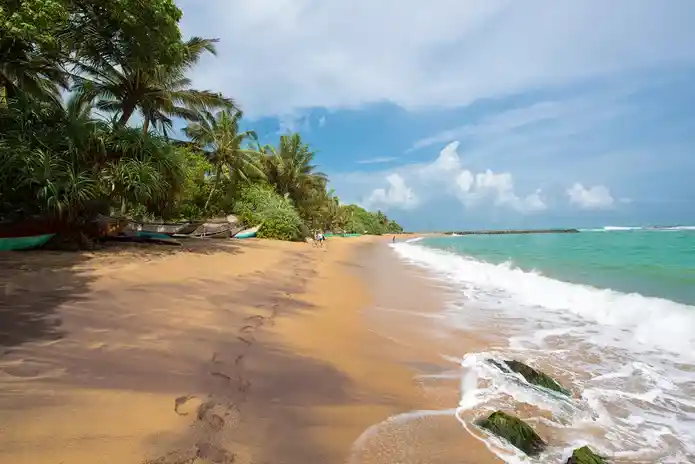
The Top 10 Destinations in Sri Lanka
Sri Lanka’s rich culture and history, gorgeous landscape and scenery, and plentiful wildlife-spotting opportunities are the main reasons the country tops many travelers’ bucket lists. And due to its relatively small size, many of the best attractions and destinations are within only a couple of hours of each other. In one day, if you’re on a tight schedule, you could spend the morning at one of the country’s eight UNESCO World Heritage sites, go on a safari in the afternoon, and then in the evening, relax and enjoy a cup of tea from one of the hill country plantations. Or, with more time, allow the opportunity for spontaneous exploration—road tripping throughout the country offers scenic views almost everywhere, and you might pull over for an elephant sighting or two along the way!
Kandy

Kandy, a major city in Sri Lanka’s hill country, is one of the most popular tourist destinations and one corner of the country’s Cultural Triangle. It’s surrounded by mountains of rainforest and tea plantations and is home to a beautiful lake within the city. Visit the Temple of the Tooth, a sacred temple that houses Buddha’s tooth; wander the city’s colorful streets, and admire the architecture while sampling food from the many street vendors; walk around the lake for scenic views of the lake itself and also the colorful buildings that dot the hillsides around it; and make the quick drive outside of the city to the Peradeniya Royal Botanical Gardens to visit its orchid house and its spice garden, the latter of which will take you on an olfactory tour of the country’s native spices.
Continue to 2 of 10 below.
02of 10
Sigiriya

This massive rock formation is not only a breathtaking sight to take in as you approach, jutting up from the flat lands that surround it but also a place of cultural and historical significance. The UNESCO World Heritage site was a fort and palace that dates back to the fifth century. A network of winding staircases and paths will lead you to the top of the rock if you’re game to do the 1,217-step climb. Along the way, you’ll get panoramic views of the valley around you, you’ll pass ancient paintings by monks on the rock walls, and learn about the kingdom that once called this rock home. If you plan on making the entire climb (which we highly recommend), arrive at the park at opening time—you’ll avoid the afternoon heat and beat most of the crowds.
Anuradhapura

Anuradhapura, one of the three corners of Sri Lanka’s Cultural Triangle and the current capital city of the North Central Province, was the first ancient capital in Sri Lanka, thriving for more than 1,300 years until it was abandoned in 993. Tourists visit this UNESCO World Heritage site to explore the well-preserved ruins and significant Buddhist history. Several dagobas, distinctive dome-shaped memorials, remain in the city, one of which is said to house Buddha’s collarbone. Another important site is the Bodhi tree found in the Mahamewna Gardens—it’s the oldest known human-planted tree in the world, and it grew from the southern branch of a sacred fig tree in India, the tree under which Gautama Buddha was said to have gained enlightenment.
Polonnaruwa

The third corner of the Cultural Triangle, Polonnaruwa became the second capital after Anuradhapura was abandoned. Like Anuradhapura, Polonnaruwa is a draw for visitors interested in touring the city’s history and ruins, including those of the royal palace and other royal spaces, the quadrangle (a raised, walled-off area of monuments and Buddha statues), and dagobas. You’ll undoubtedly spot many monkeys (toque macaques) in the area, and that population of native, endangered monkeys was featured in Disney’s nature documentary, “Monkey Kingdom.”
Yala National Park
Yala National Park, located along the southeastern coast of Sri Lanka, is the most visited national park in the country, primarily because of the chance to spot the leopards in the area—it is home to one of the largest concentrations of leopards in the world. (The land became a wildlife sanctuary in 1900 and then a national park in 1938.) Although it comprises five blocks, only two of them are open to the public for safari to preserve and protect the majority of the land. Between February and July is the best time to visit; during these months, the lower water levels bring more animals out in the open searching for water. However, the park can get crowded in these peak months, and higher traffic through the park can lessen your chances of spotting one of the elusive leopards. Even so, you’ll still have the opportunity to see elephants, crocodiles, and water buffaloes.
Minneriya National Park

Sri Lanka has plenty of safari opportunities, but Minneriya National Park is known for having the world’s largest gatherings of Asian elephants. Previously an elephant sanctuary, the land was converted to a national park in 1997, and Asian elephants still freely roam the grounds in large herds. While you’ll likely get a glimpse of several whenever you visit, the dry season from June to September is the best time to visit. This is when the elephants (sometimes as many as 300) will congregate around the reservoir. It might be most famous for these elephant sightings, but the park is also home to more than 170 species of birds, leopards, monkeys, and other wildlife.
Colombo

Many tourists skip Colombo to set off for the country’s beautiful nature destinations, but the capital city deserves some of your time. Colombo comprises several distinct neighborhoods that showcase the old and new—from ancient temples and colonial architecture to modern skyscrapers and city parks. It’s easy (and recommended) to wander and simply take in the sights as you go. One impressive architectural sight you won’t be able to miss is the Jami Ul-Alfar Masjid (also known as the Red Mosque), a red and white mosque in Colombo’s Pettah neighborhood. Admiring it from the outside is intriguing enough, but if you want to go inside, ensure you’ve dressed appropriately; women need to cover their hair, arms, and legs.
Galle

This fortified old city on the southwest coast of Sri Lanka is another of the country’s impressive UNESCO World Heritage Sites. One of the best things to do is walk along the fort’s ramparts that give you a view out to the water and inward toward the fort and city. You can also take a self-guided tour of the fort to learn about its history and architecture. Although the fort is the main attraction for visitors to the area, Galle is a prime destination for shopping as well; wander the pedestrian-friendly streets to check out the many art galleries, upscale markets, and boutique stores selling clothes, jewelry, souvenirs, and home goods.
Nuwara Eliya

Tea is one of Sri Lanka’s biggest exports, so a trip to the rolling hills of tea country is well worth your time. Nuwara Eliya boasts hundreds of acres of tea plantations and several tea production facilities you can visit to learn about the entire tea-making process, from planting to picking and steeping at home. Once you’ve had your fill of tea, be sure to explore the other gorgeous surroundings of Nuwara Eliya, such as the manicured and well-maintained Victoria Park, Lake Gregory for a day on the water, or a lakeside picnic, or the beautiful, 350-foot tall Ramboda Falls.
Mirissa

As one of the main beach destinations in the country, Mirissa attracts those looking for a laid-back, leisurely vacation of days lounging on the sand and nights out on the town. Among the gorgeous beaches in Mirissa, Mirissa Beach and Secret Beach are two of the best for their beauty and seclusion, but neither one gets too crowded. If you’d rather be out on the water, Mirissa is a surfer’s paradise, especially from October to April, and it’s also a popular destination for whale watching tours to spot blue whales. After a day in the sun, hit some of the casual but lively restaurants and bars, some of which are right along the beach, making them a perfect setting for a sunset cocktail.
Recent Posts
8 Best activities for a Sri Lanka family holiday with teenagers
Sri Lanka’s Monkey Kingdom
Sri Lanka in Summer
All Categories

Thailand





